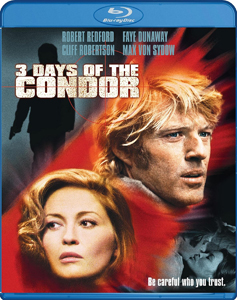Political conspiracy films were so common in the Seventies that some people were probably getting sick of them, but today they stand as a rich vein of cinema history. After co-writing “The Parallax View” (1974), Lorenzo Semple Jr. – along with David Rayfiel – mines another novel for supreme paranoia in “Three Days of the Condor” (1975).
Hero on the inside
As I sleuth for clues to “The X-Files’ ” influences, this adaptation of James Grady’s 1974 novel is an important film. Its hero comes from inside the government: low-level CIA agent Turner (Robert Redford). As Fox Mulder would learn, working for the government doesn’t necessarily give you protection from the government.
Director Sydney Pollack and the writers aim for more narrative detail than in “Parallax,” although Turner is just as confused as Warren Beatty’s reporter. It’s not too confusing for the viewer, though. Rather, it’s quite thrilling as Turner returns from lunch to find his seven co-workers murdered. The placard out front says “American Literary Historical Society,” but they are actually a New York branch of the CIA that analyzes foreign-language novels and writings for secret codes.

“Three Days of the Condor” (1975)
Director: Sydney Pollack
Writers: Lorenzo Semple Jr., David Rayfiel (screenplay); James Grady (novel)
Stars: Robert Redford, Faye Dunaway, Cliff Robertson
The “average Joe on the run” plot plays out, not with the flair of Hitchcock or the gritty style of Pakula, but with brisk pacing, a nice sense of NYC as a cold place with warm patches of Christmastime cheer, and a magnetic movie-star lead. Matching Redford in screen presence are Cliff Robertson as Higgins, a CIA boss who might be trustworthy, and Max von Sydow as terrifyingly matter-of-fact contract-killer Joubert.
Faye Dunaway is fine, but she draws an absolutely awful role as Kathy, the woman Turner kidnaps in order to get away from one attempt on his life. Their romance is never believable for a moment, even within the category of Stockholm Syndrome. This is an infamously bad subplot, even though “Condor” is a top-shelf thriller otherwise.
From Turner’s perspective, who is thinking about romance when they are running for their life, and who has seen his girlfriend (Tina Chen) killed earlier that day? From Kathy’s perspective, it’s fine to help a desperate stranger, but wouldn’t she need more time to get past the whole kidnapping thing?
The alphabet agency murders
As atrocious as the romance writing is, the conspiracy plot counters by being outstanding. In terms of the trail of clues, “Condor” is merely workmanlike, but the reveal of the villain and his aims is chilling. Replacing “Parallax’s” “We don’t know why they’re doing it,” the answer here is icily mundane.
A final sidewalk conversation between Turner and Higgins clinches “Condor” as a key piece of political conspiracy cinema. Turner believes the principles of liberty (specifically of having the right to not be murdered in a cover-up) rank above all. Higgins believes spy games are crucial to governance, because at some point in the future America will have to rely on agencies like the CIA for the very continuation of the country.

Although I side with Turner (and I think the filmmakers intend that), Higgins gives a passionate, compelling rebuttal. And granted, if we consider that the CIA and other alphabet agencies still exist to this day despite being openly loathed and unconstitutional, one has to consider that Higgins might be right. They may not admit it, but many Americans would rather have these agencies than not have them, even with the risk that they might be labeled an enemy and disappeared.
The question of how Turner should expose the CIA’s bad scheme adds extra suspense even as the film’s clock ticks down. Is telling his story to the New York Times enough? What if they don’t print it? And even if they do, he’s not safe in the meantime, even as he ducks behind a crowd of Christmas revelers.
“Three Days of the Condor’s” plot satisfyingly resolves, but as with most great Seventies conspiracy thrillers, our worries linger over the closing credits.

